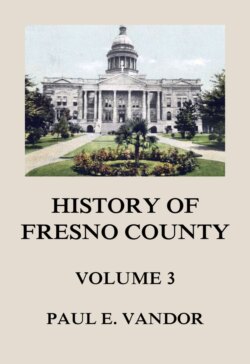Читать книгу History of Fresno County, Vol. 3 - Paul E. Vandor - Страница 22
На сайте Литреса книга снята с продажи.
WILLIAM RENNIE.
ОглавлениеFull of opportunity for travel and, it is fair to assume, of good, old-fashioned adventure, with more than a suggestion of the romantic, was the early career of the subject of this very interesting sketch, a native of "bonnie Scotland" and the son of William and Elizabeth (Rennie) Rennie of Stirlingshire, and members of the clan made famous through John Rennie, the British engineer and architect. William Rennie was a coal operator and coke and iron manufacturer in Stirlingshire, and he had offices in Glasgow, in which city, so favorably situated on the bustling and beautiful banks of the Clyde, he resided with his family. His brilliant career, however, was cut short by death when he was only thirty-nine years of age, so that the three of the five children who grew to maturity were all too soon deprived of an invaluable leader.
The second eldest in the family, William was reared in the country so dear to every Scottish heart, and in old but progressive Glasgow, a city as live with the spirit of modern times as it is full of the traditions of the past, he was educated. Arriving at the age of fourteen, he entered the Loretto School near Edinburgh, and at eighteen left the class-room to spend a year in travel over the Continent.
Attaining his majority enriched through such advantages, William went to New Zealand, a long trip to most Americans, but rather a matter-of-fact experience for a Britisher; and for six busy years he was with the New Zealand-Australian Land Company. After a while, a longing to see the old folks at home led him to start back, and in 1886 he got as far as San Francisco, but he did not reach his ancestral hearth until eighteen years later. He arrived on the Pacific Coast just at the beginning of the great "boom" in California, and from San Francisco he went to Napa County where, with his brother James, he took up the dry-wine manufacture. The firm was known as Rennie Bros., and their headquarters were at St. Helena. Thus, when he first reached the State, he got into the wine business, and he has been identified with it for thirty fruitful years, during which time he did much to raise the standards governing that industry. He bought property in St. Helena, Napa County, set out his vineyard, and constantly adding improvements, kept it until 1904 when he sold it. Besides building the finely-planned and equipped winery at St. Helena, he was also instrumental in putting up the first stone bridge — of gray stone blocks — constructed in Napa County.
When Mr. Rennie came to Fresno County in 1900, he took charge of the Barton Vineyard which included 960 acres of land situated about two and a half miles northeast of the court house, succeeding Colonel Trevalyan who had been superintendent of the place for fourteen or fifteen years. Wine, raisin and table grapes were grown, and there was plenty to do. The Barton Vineyard, in fact, was one of the first vineyards to be set out in that section; there were 150 acres given to raisin grapes, 100 to table grapes, and 500 to wine grapes; 100 acres were also devoted to grain and buildings; 4,500 tons of grapes a year were turned into wine, making about 325.000 gallons of the favorite beverage; while for ten years, from 1905 to 1915, the average crush was 11,800 tons, aggregating almost one million gallons of wine, and from 100,000 to 250.000 gallons of commercial brandy a year. In 1915, however, fire destroyed a part of the winery, causing a loss of $190,000, including cooperage, wine-making machinery and buildings, and 800,000 gallons of wine.
Mr. Rennie also owns other acreage devoted to horticulture and viticulture, and he is interested in quicksilver mining in Napa County. He was a director in the Central Bank of California at Fresno, and both because of striking personality and high, unswerving standards in all of his business methods, and his long career as a man of affairs, he is still looked to as a pillar of financial strength and a leader whose experience and judgment are of real value in commercial undertakings. He is a stanch Republican and Protectionist, and not only supports every movement for the betterment of the locality, but takes an active part in national politics and the advancement of American political and commercial interests.
Modest by nature, yet liberal-hearted, Mr. Rennie finds pleasure in doing and giving, but all his benefactions are wrought in an unostentatious manner, so that often the right hand does not know what the left has accomplished. Particularly may he be proud of his Masonic record, for he was made a Mason in one night, by special dispensation of the Grand Lodge of Scotland, at the Robert Burns Lodge at Dumfries. He was also a member of the Knight Templars and affiliated with the Napa Commandery.
Two children, a daughter and a son, are the joy of Mr. and Mrs. Rennie's home. Miss Elizabeth leads in social movements, while William Rennie is at present serving in the United States Army, and was recently for thirteen months over-seas. He belonged to the American Expeditionary Forces that have effected so much for the military glory of the nation; and, just before the armistice was signed, he passed all the requisite examinations as a candidate for officer.
